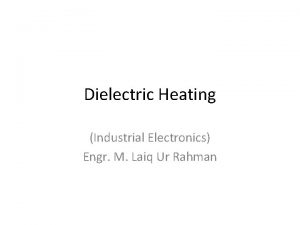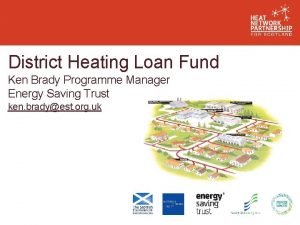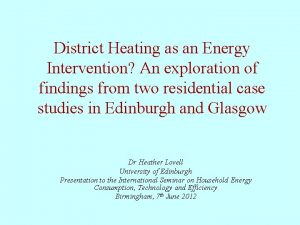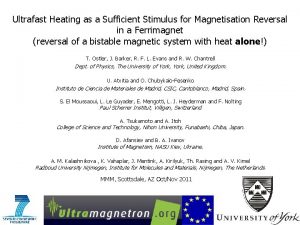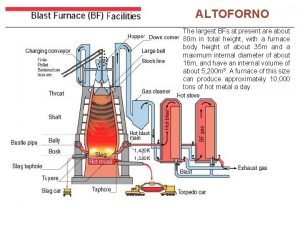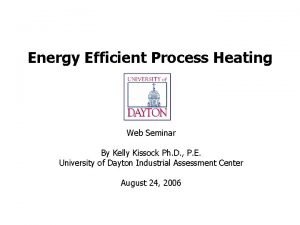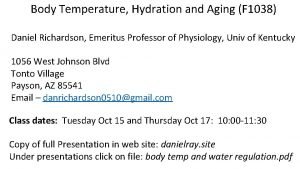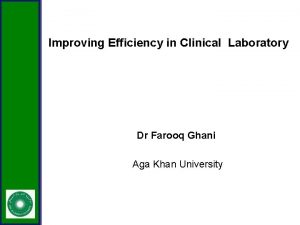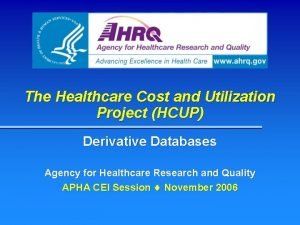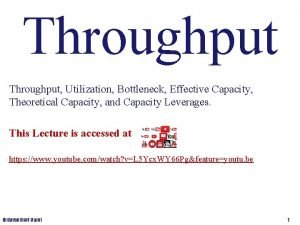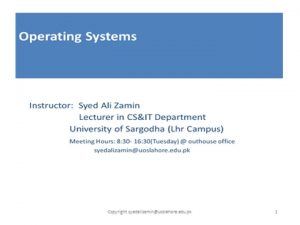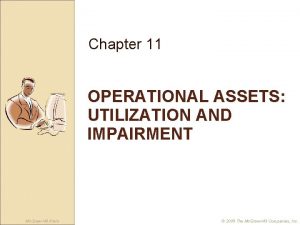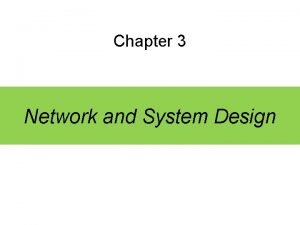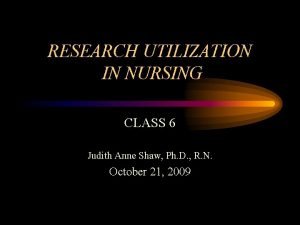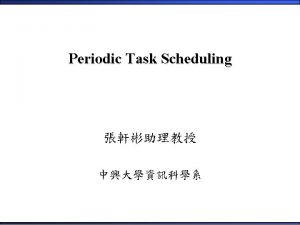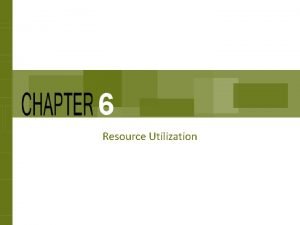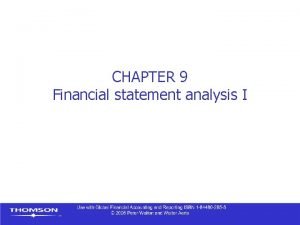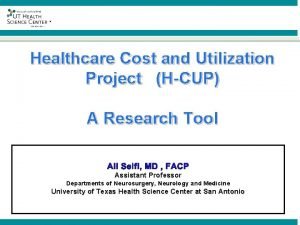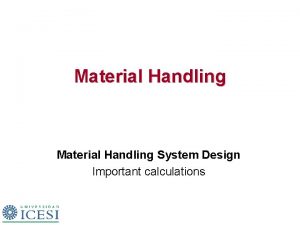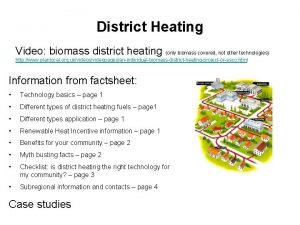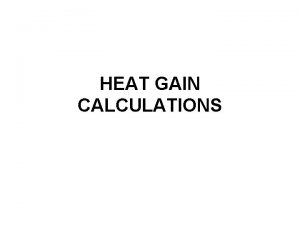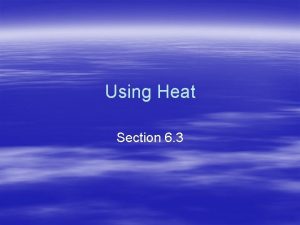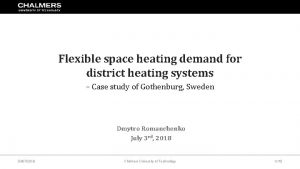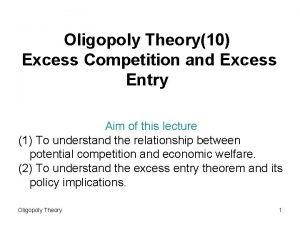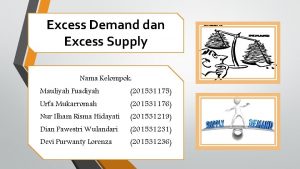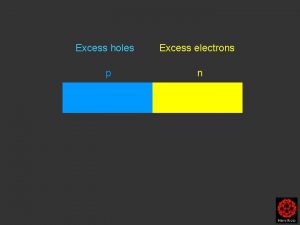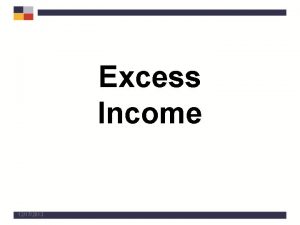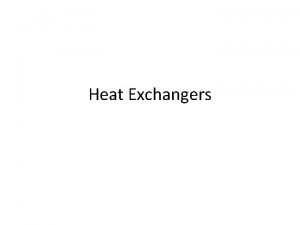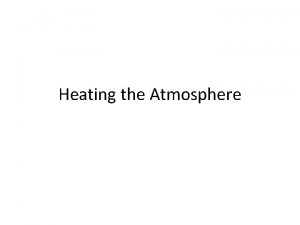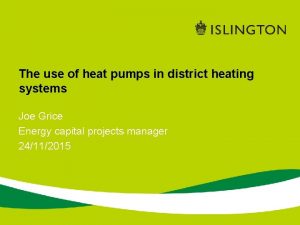Utilization of excess heat for district heating in






























- Slides: 30

Utilization of excess heat for district heating in the future Danish energy system Stefan Petrovic, Fabian Bühler & Mikkel Bosack Simonsen SDEWES conference, Dubrovnik 06. 10. 2017.

Plan of presentation • Previous research • TIMES models • TIMES-DK model • Analysed scenarios • Results • Sensitivity analysis • Conclusion • Future work 2 Utilization of excess heat for district heating in the future Danish energy system 12/12/2021

Previous work • District heating in Denmark should be expanded in the future • Excess heat should contribute to district heating production • The role of industrial excess heat is not analysed in more details • In previous work we have allocated excess heat to single production units • Excess heat is defined in 15 temperature intervals • We have performed spatial analysis (using the cut-off distance) • 5. 1% of DH demand can be supplied by industrial excess heat from thermal processes • What if we let the model to decide? 3 Utilization of excess heat for district heating in the future Danish energy system 12/12/2021

Previous work – Excess heat density Bühler F. , Petrovic S. , Karlsson K. B. & Elmegaard B. (2017). Industrial excess heat for district heating in Denmark. Applied Energy. 205. 991 -1001. Utilization of excess heat for district heating in the future Danish energy system 12/12/2021

Previous work – from theoretical to practical potential Bühler F. , Petrovic S. , Karlsson K. B. & Elmegaard B. (2017). Industrial excess heat for district heating in Denmark. Applied Energy. 205. 991 -1001. Utilization of excess heat for district heating in the future Danish energy system 12/12/2021

Previous work – share of DH demand which can be covered by industrial excess heat Bühler F. , Petrovic S. , Karlsson K. B. & Elmegaard B. (2017). Industrial excess heat for district heating in Denmark. Applied Energy. 205. 991 -1001. Utilization of excess heat for district heating in the future Danish energy system 12/12/2021

TIMES models • TIMES is multi-regional, technology-rich, bottom-up model generator • Techno-economic, partial equilibrium model generator assuming full foresight and perfectly competitive markets • Used for long-term analysis and planning of regional, national and multi-national energy systems • Simultaneous optimisation over a whole energy system and over all periods • Based on welfare maximisation by minimisation of the total system costs. • Inputs are defined by the user: exogenous service demand curves, supply curves, policies and techno-economic parameters. 7 Utilization of excess heat for district heating in the future Danish energy system 12/12/2021

TIMES-DK – energy flows 8 Utilization of excess heat for district heating in the future Danish energy system 12/12/2021

TIMES-DK – geographical structure 9 Utilization of excess heat for district heating in the future Danish energy system 12/12/2021

TIMES-DK – geographical structure 10 Utilization of excess heat for district heating in the future Danish energy system 12/12/2021

TIMES-DK – Industrial excess heat Seasonal COPs defined for - DKE/DKW - Central/Decentral Low Temp Excess Heat Intermediate Heat Exchanger Low Temp Heat Pump Medium Temp Excess Heat Intermediate Heat Exchnager Medium Temp Heat Pump High Temp Excess Heat Intermediate Heat Exchanger Potentials: • Central/Decentral • DKE/DKW • Inside/3 steps outside of DH areas No Cost in the Base runs Inv. Costs Efficiency Fix O&M Variable O&M Inv. Costs COP Fix O&M Variable O&M - Inside DH areas - 3 steps outside of DH areas Connection to district heating network Inv. Costs Efficiency Fix O&M Variable O&M District heating network 11

Analysed scenarios • EH_Base – 50% of electricity production from wind from 2020 • EH_2050 – 50% of electricity production from wind from 2020 Fossil fuel free energy system from 2050 • EH_2035 – 50% of electricity production from wind from 2020 Fossil fuel free energy system from 2050 No fossil fuels in production of electricity and from 2035 Utilization of excess heat for district heating in the future Danish energy system 12/12/2021

Results – Residential heat production Utilization of excess heat for district heating in the future Danish energy system 12/12/2021

Results – share of DH in residential heating Utilization of excess heat for district heating in the future Danish energy system 12/12/2021

Results - District heating production Utilization of excess heat for district heating in the future Danish energy system 12/12/2021

Results – Industrial Excess heat and biorefinaries Utilization of excess heat for district heating in the future Danish energy system 12/12/2021

Results – Share of DH produced from industrial EH Utilization of excess heat for district heating in the future Danish energy system 12/12/2021

Results – Excess heat at different temperatures Utilization of excess heat for district heating in the future Danish energy system 12/12/2021

Sensitivity analysis Excess heat potentials • • • Energy efficiency measures with 10 year pay back time – fixed from 2015 to 2050 No efficiency +50% compared to existing potential THERMCYC projct (22. 6 PJ; more manufacturing industries and more processes) Base potential linearly reduces to 50% in 2035 Base potential linearly reduces to 50% in 2050 Excess heat costs • • 10 20 15 30 DKK/GJ EUR/MWh=31 DKK/GJ EUR/MWh=62 DKK/GJ EH_2050 scenario is the basis for the sensitivity analysis Utilization of excess heat for district heating in the future Danish energy system 12/12/2021

Sensitivity analysis Excess heat potentials • Energy efficiency measures with 10 year pay back time – fixed from 2015 to 2050 • No efficiecny • +50% compared to existing potential • THERMCYC projct (22. 6 PJ; more manufacturing industries and more processes) • Base potential linearly reduces to 50% in 2035 • Base potential linearly reduces to 50% in 2050 Excess heat costs • 10 DKK/GJ • 20 DKK/GJ • 15 EUR/MWh=31 DKK/GJ • 30 EUR/MWh=62 DKK/GJ EH_2050 scenario is the basis for the sensitivity analysis Utilization of excess heat for district heating in the future Danish energy system 12/12/2021

Sensitivity analysis – excess heat potentials Utilization of excess heat for district heating in the future Danish energy system 12/12/2021

Sensitivity analysis – industrial excess heat share in DH production Utilization of excess heat for district heating in the future Danish energy system 12/12/2021

Sensitivity analysis – change of DH prices Maximum and minimum changes • For all years from 2010 to 2050 • For all sensitivity actions Min DKE DKW Max HETC -9. 4% 5. 8% HETD -1. 0% 1. 8% HETC -26. 3% 7. 5% HETD -2. 4% 2. 2% 62 DKK/GJ THERMCYC project (22. 6 PJ) Utilization of excess heat for district heating in the future Danish energy system 12/12/2021

Conclusions • Industrial excess share in DH production of 5% • With biorefinaries the share grows up to around 20% • In DKW the share of industrial excess in DH production is 7 -8% • 70 -80% of excess heat is high temperature • If potentials from THERMCYC project are included, 12 -14% of DH production can come from industrial excess heat

Future work • Temporal profiles for excess heat (currently uniform over a year) • Sensitivity analysis on the costs and efficiencies of competing technologies - large scale heat pumps and electric boilers • Finding appropriate value for socio-economic cost of excess heat • Private-economic analysis (tax on excess heat is a big topic in Denmark)

Thank you for you attention! Stefan Petrović Fabian Bühler Mikkel Bosack Simonsen Postdoc Systems Analysis division DTU management Engineering Ph. D Student Section of Thermal Energy DTU Mechanical Engineering Research Assistant Systems Analysis division DTU management Engineering Email Phone stpet@dtu. dk +45 24655732 fabuhl@mek. dtu. dk +45 22471020 mibsi@dtu. dk +45 29383337

Previous work – share of DH demands and obtainable COPs DKE DKW DH demand (TWh) DH (TWh) Within DH+HP (TWh) DH demand (%) DH (TWh) Not within DH+HP (TWh) DH demand (%) Central DKE 7. 728 0. 045 0. 195 2. 5% 0. 003 0. 011 0. 1% Decentral DKE 2. 684 0. 046 0. 129 4. 8% 0. 016 0. 042 1. 6% Central DKW 9. 179 0. 446 0. 823 9. 0% 0. 007 0. 021 0. 2% Decentral DKW 7. 072 0. 124 0. 215 3. 0% 0. 087 0. 195 2. 8% Bühler F. , Petrovic S. , Karlsson K. B. & Elmegaard B. (2017). Industrial excess heat for district heating in Denmark. Applied Energy. 205. 991 -1001. Utilization of excess heat for district heating in the future Danish energy system 12/12/2021

TIMES-DK – temporal definition • No chronological values • 32 time-slices 28 Utilization of excess heat for district heating in the future Danish energy system 12/12/2021

Sensitivity analysis Utilization of excess heat for district heating in the future Danish energy system 12/12/2021

Sensitivity analysis – CO 2 emissions Utilization of excess heat for district heating in the future Danish energy system 12/12/2021
 Dielectric heating formula
Dielectric heating formula Ken brady
Ken brady Termis district heating software
Termis district heating software Wyndford estate glasgow district heating
Wyndford estate glasgow district heating Jgd district heating
Jgd district heating Excess heat reduce
Excess heat reduce Jrmin
Jrmin Excess heat reduce
Excess heat reduce Excess heat reduce
Excess heat reduce Dr farooq ghani
Dr farooq ghani Va office of small and disadvantaged business utilization
Va office of small and disadvantaged business utilization Healthcare utilization project
Healthcare utilization project Bottleneck utilization
Bottleneck utilization Basic unit of cpu utilization
Basic unit of cpu utilization Data utilization strategies
Data utilization strategies Assets utilization
Assets utilization Utilization factor
Utilization factor Packet utilization standard
Packet utilization standard Bandwidth utilization multiplexing and spreading
Bandwidth utilization multiplexing and spreading Capacity utilization formula
Capacity utilization formula Citrate utilization test
Citrate utilization test Define research utilization
Define research utilization Research utilization process steps
Research utilization process steps Warehouse goals
Warehouse goals Cpu utilization factor
Cpu utilization factor A resource requirements plan illustrates
A resource requirements plan illustrates Asset utilization formula
Asset utilization formula Cisco bandwidth utilization calculation
Cisco bandwidth utilization calculation Healthcare utilization project
Healthcare utilization project Motor equipment utilization record
Motor equipment utilization record Cube utilization formula
Cube utilization formula
